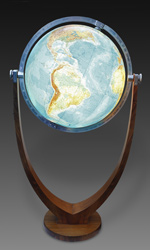A New Spin on an Old Debate – Globe Collectibles
PRIMITIVE - Friday, October 10, 2014 |
|
By Misaki Imagawa
Below is a transcript from a fictional conference held at PRIMITIVE to determine who discovered America?
Welcome attendees. Today we are holding a conference to debate a topic of much contention: Who discovered America?
“I did, of course,” said Columbus. “October 12, 1492. There’s even a federal holiday in my honor.”
“Well technically,” said Zuan Chabotto, also known as John Cabot in England, “you landed on Cuba and Hispaniola, not mainland America. I landed in America a full year before you did.”
“And he set sail from England,” yelled an Englishman from the audience. “He even received funds from King Henry VII.”
“Ah, excuse me,” interrupted another audience member, this time an Italian. “Henry only gave him a fraction of what he needed. Chabotto’s main investor was an Italian banking house in London. We financed the voyage.”
“Wait a minute,” said Englishman, John Day. “I wrote a letter to Columbus in 1498 saying that the land Cabot ‘discovered’ had already been discovered by English seamen as early as 1470.”
 |
|
A moment of silence descended on the room. Then the Viking Leif Erikson from Greenland spoke up. “I was long gone by 1470. It was around the year 1000 that I took 35 of my men and set sail to the west.”
Bjarni Herjolfsson, the Icelandic trader said, “I told Erikson about the time I was blown off course some ten years before that and saw this mysterious land to the west of Greenland.”
“We landed and spent a winter in Vinland,” Erikson said. “I believe it is now called Newfoundland.”
“Yes, but we discovered the American continents 40,000 years ago,” said a weathered Chinese sailor, quickly joining the debate. “We drew a map to prove it,” pulling a scroll from his coat.
“That’s unsubstantiated!” declared Chabotto. “There’s no way you can prove its authenticity. Here’s a copy of a European map created in the 17th century. It proves I was the first to set sail to America with the intention of finding America.”
“It’s still Columbus Day, not Chabotto Day,” declared Columbus.
“Argue all you want,” said a Native American addressing the entire assembly. “We were here first.”
The topic of who discovered what and when has long been debated by historians whom may never come to a singular agreement. One thing is certain: humans have continually dreamt of faraway lands and set sail to voyage to the edges of the earth and beyond. As with all things in human history, people have striven to leave records of their voyages and discoveries. From the earliest maps that were mere lines and dots on a cave wall to increasingly detailed and accurate world maps and globes, the field of cartography reflects humankind’s political and geographic history.
 |
 |
|
In the 2nd century BC, roughly a century after the notion of a spherical Earth was accepted in Greece, Crates of Mallus created the earliest known globe. You can imagine the staggering transformations globes underwent as new continents and countries were discovered over the centuries. Each time a new discovery was made or a change took place – for example, one country or empire was replaced by another - globes previously created became a window into the past, in essence, a spherical snapshot in time and therefore highly collectible. However, it isn’t just world changes that make the many globes in PRIMITIVE’s collection worth owning; it is also their artful craft and design.
 |
|
Part of the allure of globes is they make the world look smaller and more accessible. It doesn’t take hours on a plane or days in a car to cross the United States – it’s simply the slide of a finger across a rounded map. Going from Europe to Asia is just a small spin on the globe’s axis. Suddenly friends and family living on the other side of the world don’t seem so far away. Even the vastness of the Universe may not seem so daunting. Pick a place on the map and put yourself in the shoes of Columbus, Chabotto or Erikson. Can you see Cuba, Newfoundland, the new world? Become one of those voyagers who sought fame, fortune and adventure mapping the world. Smell the ocean, see the wind billowing the ship’s sails, listen to the creaking and groaning of the ship as it cuts through the waves and rides the swells. Ahead lays undiscovered lands. Your hands are not just touching a spherical map. They are connecting you to the accumulated experiences of every pioneer who has gone before, every single person who has opened their eyes and decided to take the world in their hands.

|
|
Download this Article: A New Spin On An Old Debate.pdf